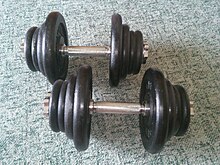Weight plate: Difference between revisions
Father Goose (talk | contribs) ←Created page with 'thumb|right|A weightlifter holding an [[Olympic_weightlifting#Barbell|Olympic barbell loaded with plates ranging from 25 to 5 kilogram...' |
(No difference)
|
Revision as of 23:03, 18 November 2016



A weight plate is a flat, heavy object, usually made of cast iron,[1] that is used in combination with barbells or dumbbells to produce a bar with a desired total weight.
Two general categories exist: "standard" plates, which have a center hole of approximately one inch (25mm), and "Olympic" plates, meant to fit on the two-inch (50mm) sleeves of Olympic barbells.[2] Standard plates are usually paired with adjustable dumbbells and Olympic plates with full-size barbells, although standard barbells and Olympic dumbbells exist.[3][4]
Weight plates may incorporate holes for ease of carrying (called "grip plates") or be solid discs (especially those used for competition). Non-competition plates often have variable diameters and widths, such as on the adjustable dumbbells pictured right, with heavier plates generally being larger in diameter, thickness, or both. Weight plates are typically round, although 12-sided and other polygonal varieties exist.[5] Most plates are coated with enamel paint or hammertone to resist corrosion; more expensive varieties may be coated with chrome, rubber, or plastic.[6][7]
Plate sizes
Weight plates come in a variety of denominations.
Standard (1-inch center hole) plates are commonly available in 2.5, 5, 10, and 25 lb. denominations, with 1.25, 7.5, 12.5, 50, and 100 pound plates less commonly seen.[8] Commonly available plates with kilogram denominations are 1.25, 2.5, 5, 10, 15, and 20 kilograms,[9] with 0.5, 7.5, and 25 kilogram plates less commonly seen.[10][7]
Common Olympic (2-inch center hole) plate denominations are 2.5, 5, 10, 25, 35, and 45 lbs.,[11] with 1.25 and 100 pound discs less commonly seen. Kilogram-denominated plates are available in 1.25, 2.5, 5, 10, 15, 20, and 25 kg sizes,[12] with 0.25, 0.5, and 50 kilogram discs less commonly seen.[13]
A few companies sell "fractional" weight plates, weighing less than 1 lb. (0.5 kg) each. These allow "microloading" of bars to achieve very small increments in strength for advanced strength trainees.[14] An alternative for microloading is to use a set of washers with one- or two-inch center holes.[15]
Weight accuracy
Low-cost plates can vary widely from their marked denomination. A 2% or 3% variation is not uncommon, with plates from some manufacturers being 10% or more over or under (a 45-lb. plate can weigh as little as 40 lbs. or as much as 50).[6][16][17] Tom Lincir, founder of the Ivanko Barbell Company, has encountered 45-lb. plates weighing as little as 38 pounds, or as much as 59 pounds.[18]
Strength training coach Mark Rippetoe recommends weighing plates on a scale and marking the results on the equipment with a paint pen or other permanent marker.[19]
Calibrated plates are available from high-end manufacturers; many advertise these plates as being accurate to within 10 grams (0.02 lbs.) of marked weight.[20][21]
Bumper plates
Olympic plates may come in the form of bumper plates, which are made of resilient rubber. Lower-end bumper plates are generally made of solid rubber with a steel or brass hub. Competition-grade bumper plates are more compact, with a layer of rubber surrounding a steel core.[22] Bumper plates permit a loaded barbell to be dropped (and to bounce) after a lift, with negligible damage to the floor, plates, and bar.[23]
Bumper plates used in competition have a mandated diameter of 450 millimetres (17.72 in), with lighter plates being narrower than heavier plates.[6]
As an alternative to rubber plates, "technique plates", made of plastic, are available. Technique plates are more expensive than rubber, but hold up better to repeated drops. Their primary purpose is to allow novice lifters to practice olympic lifts at lighter weights that can put too much lateral stress on single pairs of rubber plates, damaging them.[24]
Vinyl plates
Standard (1-inch hole) "vinyl" plates are often sold paired with dumbbells or barbells as a low-cost option for casual strength training. These plates are made of cement or sand coated with a polyvinyl chloride sheath. The cement tends to break down over time and leak out of the vinyl, and the weights are less dense than iron, meaning fewer can be fit on a given bar.[25]
Weight stacks

Weight machines commonly use specialized sets of plates (called "weight stacks"), consisting of a set of rectangular plates mounted on rails. The load is transmitted to the user of the machine via a cable and pulley arrangement. The amount of weight used is selected by inserting a pin in the stack that causes each plate above the pin to be pulled by the cable. This arrangement is known as a "selectorized" weight machine.[26]
Some weight machines, such as the sled-type leg press, are designed to be loaded with Olympic plates instead of using a cable-driven stack.[26]
References
- ^ http://www.dickssportinggoods.com/products/cast-iron-weight-plates.jsp
- ^ http://www.livestrong.com/article/1010395-olympic-weights-vs-standard-weights/
- ^ http://www.powerhouse-fitness.co.uk/bodymax-6-ft-standard-spinlock-barbell-with-collars.php
- ^ https://christiansfitnessfactory.com/olympic-dumbbell-handle.html
- ^ http://capbarbell.com/cap-barbell-12-sided-2-cast-iron-grip-plate-gray/
- ^ a b c http://blog.adamantbarbell.com/639/barbell-weight-plates-a-comparison-of-iron-and-rubber-models/
- ^ a b http://www.mcsport.ie/p/bodymax-1-hammertone-weight-discs/p-wtsw0001
- ^ https://www.scribd.com/document/97692068/CAP-Barbell-Catalog
- ^ https://www.worldfitness.com.au/index.php?cPath=7_23
- ^ https://www.viavito.com/weight-training/weight-plates/cast-iron-standard-weight-plates.html
- ^ Stoppani, Jim (1 October 2014). Jim Stoppani's Encyclopedia of Muscle & Strength, 2E. Human Kinetics. pp. 27–. ISBN 978-1-4504-5974-7.
- ^ http://www.mcsport.ie/p/bodymax-olympic-trigrip-grip-discs/p-wtow0038
- ^ http://www.ivankobarbell.com/products/cbpp/
- ^ https://stronglifts.com/microloading-small-fractional-plates-iron-woody/
- ^ https://mannixcastro.com/2011/10/08/cheap-fractional-plates-for-microloading/
- ^ http://forum.bodybuilding.com/showthread.php?t=1988221
- ^ http://forum.bodybuilding.com/showthread.php?t=140015253
- ^ Lincir, Tom (Summer 2001). "The Making of a Perfect Olympic Plate" (PDF). National Fitness Trade Journal. Retrieved 2016-11-18.
- ^ https://www.youtube.com/watch?v=V7pVtXPYtGM&t=5m41s
- ^ http://www.roguefitness.com/rogue-calibrated-kg-steel-plates
- ^ http://www.ivankobarbell.com/products/ocb/
- ^ https://bumperplates.com/bumper-plates-faq/
- ^ http://blog.vulcanstrength.com/2014/02/about-bumper-plates.html
- ^ http://www.garage-gyms.com/10-pound-bumpers-vs-technique-plates/
- ^ http://www.stayfitbug.com/the-fitness-bug/vinyl-weights-or-cast-iron-weights/
- ^ a b http://www.empire-fitness-services.com/Fitness-Equipment-Articles/Plate-Loaded-vs-Selectorized-Gym-Equipment.htm
